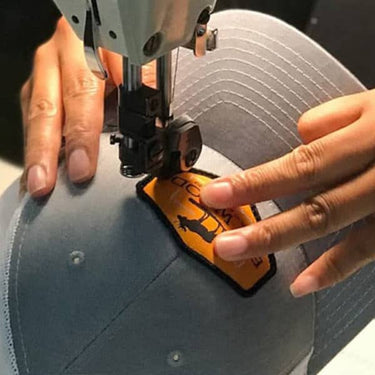Materials and Uses of Custom Embroidery Patches
Exploring Custom Embroidery Patches
Main Categories of Patches
Embroidery patches can be broadly classified into two main categories: functional patches and decorative patches. Each serves a distinct purpose and is designed differently to meet specific needs.
Functional Patches
Functional patches are primarily used for labeling or providing information. These patches typically do not have any coloration in their designs. Instead, images or text are printed directly onto the front of the patch. For example, a soldier’s name and rank on a military uniform are often displayed using functional patches. These patches are straightforward and serve a practical purpose, ensuring that essential information is easily visible.

Decorative Patches
On the other hand, decorative patches are all about adding flair and personality to items. These patches have images or designs inked directly into the material, making them visually appealing. They are commonly used on items like backpacks, jackets, and hats to give them a unique and personalized look. Decorative patches allow individuals to express their style and make a statement with their accessories.
Functional Patch Variants
Functional patches can be further divided into two main variants: sew-in (sew-through) patches and iron-on patches. Each type has its own method of application and specific use cases.
| Variant | Application Method | Features | Ideal For |
|---|---|---|---|
| Sew-in Patches | Sew through holes | Durable, Secure attachment | Frequent use, Washing |
| Iron-on Patches | Heat from iron | Convenient, Strong bond | Quick customization, Light use |
Sew-in (Sew-through) Patches
Sew-in patches require thread to be sewn through holes in the patch to attach it to the fabric. These patches often have images printed directly onto the front and may come with an adhesive backing for easier application. The adhesive backing allows for temporary placement before sewing, ensuring the patch stays in place during the sewing process. Sew-in patches are durable and provide a secure attachment, making them ideal for items that undergo frequent use or washing.
Iron-on Patches
Iron-on patches, as the name suggests, require heat from an iron to bond with the surface of the fabric. These patches also have images printed directly onto the front and often come with an adhesive backing. The heat from the iron activates the adhesive, creating a strong bond between the patch and the fabric. Iron-on patches are convenient and easy to apply, making them a popular choice for quick and temporary customization. They are perfect for items that do not require frequent washing or heavy use.
Customization and Materials
Custom embroidery patches offer a wide range of customization options and can be made from various materials depending on their intended purpose. The choice of material plays a crucial role in the patch’s durability, appearance, and functionality.
Material Options
- Twill: A common material for patches, twill provides a sturdy base for both functional and decorative patches. It is durable and can withstand frequent use and washing.
- Felt: Often used for decorative patches, felt offers a soft and fuzzy texture. It is ideal for patches with intricate designs and adds a unique tactile element.
- Chenille: Known for its fuzzy surface, chenille is used for patches that require a plush and textured look. It is commonly used for varsity letters and other decorative patches.
- Bullion: Made with felt, wire, and beads, bullion patches are hand-constructed and highly durable. They are used for formal occasions and on items like fraternity robes and military uniforms.
Practical Applications
Custom patches can be used on any type of cloth and are practical for a variety of applications. They are commonly seen on military uniforms, factory uniforms, branded caps, and bags. Custom patches provide a professional and cohesive look, making them an excellent choice for organizations and businesses. They also offer a fun and creative way to personalize clothing and accessories, allowing individuals to stand out and make a statement.
In conclusion, custom embroidery patches are versatile and can be tailored to meet specific needs. Whether for functional purposes or decorative flair, these patches offer endless possibilities for customization and personalization. By understanding the different categories, variants, and materials available, you can choose the perfect patch for your needs and create a unique and personalized look.
Specific Custom Patch Types
| Patch Type | Surface Texture | Design Complexity | Common Applications |
|---|---|---|---|
| Chenille Patches | Fuzzy | Simple designs | Varsity jackets, Sports apparel |
| Printed Patches | Flat | Intricate designs | Detailed logos, Vibrant artwork |
| Patches With Names | Flat | Simple, Two colors | Work shirts, Uniforms |
| Woven Patches | Flat | High detail | Company logos, Detailed artwork |
| Bullion Patches | Luxurious | Hand-constructed | Fraternity robes, Formal attire |
| Embroidered Patches | Raised | Versatile | Branding, Personal expression |
Chenille Patches
Chenille patches are known for their distinctive fuzzy surface. These patches consist of two layers: the top layer provides the fuzzy texture, while the bottom layer is made of felt. This combination gives chenille patches a soft and plush feel. However, due to their construction, they are typically limited to simpler designs. Despite this limitation, chenille patches can be crafted into any shape, making them versatile for various applications. They are often used in varsity jackets and sports team apparel, adding a touch of classic style.
Printed Patches
Printed patches involve a more complex manufacturing process compared to other types. The design is directly printed onto a blank twill basis using a technique called sublimation. This method allows the colors to blend seamlessly into the fabric, resulting in a flat surface impression. One of the significant advantages of printed patches is the endless color possibilities they offer. This makes them ideal for intricate designs that require a wide range of colors. Whether it’s a detailed logo or a vibrant artwork, printed patches can bring any design to life with precision and clarity.
Patches With Names
Patches with names are a common sight on work shirts, especially in environments where formal ID cards are not always practical. These patches feature a simple design, usually with just two color options. This simplicity makes them inexpensive and easy to produce in large quantities. They are functional and straightforward, providing a clear and professional way to display names on uniforms. This type of patch is ideal for businesses looking to outfit their employees with personalized name tags without breaking the bank.
Woven Patches
Woven patches are similar to embroidered patches but use thinner thread, allowing for better detail in the design. Unlike embroidered patches, woven patches do not have a twill basis, resulting in a flat texture. This makes them perfect for achieving lifelike impressions of designs. The thinner thread provides more space to work with, enabling intricate details and fine lines to be captured accurately. Woven patches are often used for designs that require a high level of detail and precision, such as company logos or detailed artwork.
Bullion Patches
Bullion patches are the epitome of elegance and durability, often used for more formal occasions. These patches are made with a combination of felt, wire, and beads, giving them a luxurious and high-quality appearance. They are hand-constructed, which adds to their durability and uniqueness. Bullion patches are traditionally used on fraternity robes, military uniforms, and other formal attire. Their intricate construction and use of premium materials make them stand out, adding a touch of sophistication to any garment.
Patches With Embroidery
Embroidered patches are the most preferred type of personalized patch in today’s market. They are cost-effective yet stylish, making them a popular choice for customizing apparel and gear. These patches have a weave basis, and the pattern or name is stitched with thread, giving them a raised appearance. This texture adds depth and dimension to the design, making it stand out. Embroidered patches are versatile and can be used for a wide range of applications, from branding to personal expression. Whether it’s a company logo or a unique design, embroidered patches offer a classic and timeless way to customize clothing and accessories.
By understanding the different types of custom patches available, you can choose the one that best suits your needs. Whether you need something simple and functional or intricate and formal, there’s a custom patch type that will meet your requirements.


